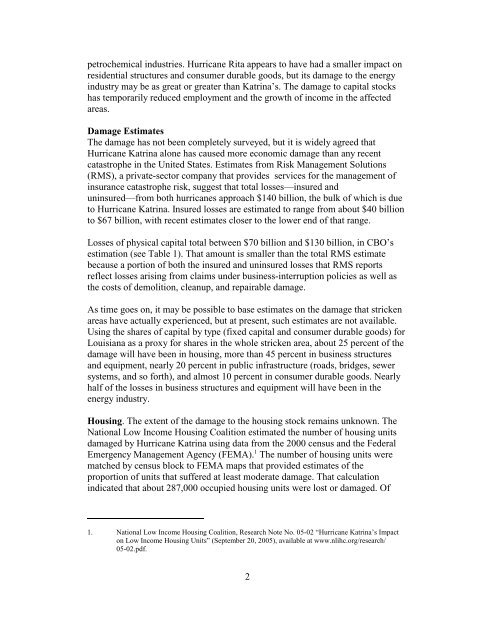Macroeconomic and Budgetary Effects of Hurricanes Katrina and Rita
Macroeconomic and Budgetary Effects of Hurricanes Katrina and Rita
Macroeconomic and Budgetary Effects of Hurricanes Katrina and Rita
You also want an ePaper? Increase the reach of your titles
YUMPU automatically turns print PDFs into web optimized ePapers that Google loves.
petrochemical industries. Hurricane <strong>Rita</strong> appears to have had a smaller impact on<br />
residential structures <strong>and</strong> consumer durable goods, but its damage to the energy<br />
industry may be as great or greater than <strong>Katrina</strong>’s. The damage to capital stocks<br />
has temporarily reduced employment <strong>and</strong> the growth <strong>of</strong> income in the affected<br />
areas.<br />
Damage Estimates<br />
The damage has not been completely surveyed, but it is widely agreed that<br />
Hurricane <strong>Katrina</strong> alone has caused more economic damage than any recent<br />
catastrophe in the United States. Estimates from Risk Management Solutions<br />
(RMS), a private-sector company that provides services for the management <strong>of</strong><br />
insurance catastrophe risk, suggest that total losses—insured <strong>and</strong><br />
uninsured—from both hurricanes approach $140 billion, the bulk <strong>of</strong> which is due<br />
to Hurricane <strong>Katrina</strong>. Insured losses are estimated to range from about $40 billion<br />
to $67 billion, with recent estimates closer to the lower end <strong>of</strong> that range.<br />
Losses <strong>of</strong> physical capital total between $70 billion <strong>and</strong> $130 billion, in CBO’s<br />
estimation (see Table 1). That amount is smaller than the total RMS estimate<br />
because a portion <strong>of</strong> both the insured <strong>and</strong> uninsured losses that RMS reports<br />
reflect losses arising from claims under business-interruption policies as well as<br />
the costs <strong>of</strong> demolition, cleanup, <strong>and</strong> repairable damage.<br />
As time goes on, it may be possible to base estimates on the damage that stricken<br />
areas have actually experienced, but at present, such estimates are not available.<br />
Using the shares <strong>of</strong> capital by type (fixed capital <strong>and</strong> consumer durable goods) for<br />
Louisiana as a proxy for shares in the whole stricken area, about 25 percent <strong>of</strong> the<br />
damage will have been in housing, more than 45 percent in business structures<br />
<strong>and</strong> equipment, nearly 20 percent in public infrastructure (roads, bridges, sewer<br />
systems, <strong>and</strong> so forth), <strong>and</strong> almost 10 percent in consumer durable goods. Nearly<br />
half <strong>of</strong> the losses in business structures <strong>and</strong> equipment will have been in the<br />
energy industry.<br />
Housing. The extent <strong>of</strong> the damage to the housing stock remains unknown. The<br />
National Low Income Housing Coalition estimated the number <strong>of</strong> housing units<br />
damaged by Hurricane <strong>Katrina</strong> using data from the 2000 census <strong>and</strong> the Federal<br />
Emergency Management Agency (FEMA). 1 The number <strong>of</strong> housing units were<br />
matched by census block to FEMA maps that provided estimates <strong>of</strong> the<br />
proportion <strong>of</strong> units that suffered at least moderate damage. That calculation<br />
indicated that about 287,000 occupied housing units were lost or damaged. Of<br />
1. National Low Income Housing Coalition, Research Note No. 05-02 “Hurricane <strong>Katrina</strong>’s Impact<br />
on Low Income Housing Units” (September 20, 2005), available at www.nlihc.org/research/<br />
05-02.pdf.<br />
2
















